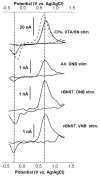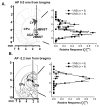In vivo voltammetric monitoring of norepinephrine release in the rat ventral bed nucleus of the stria terminalis and anteroventral thalamic nucleus
- PMID: 20128849
- PMCID: PMC2852115
- DOI: 10.1111/j.1460-9568.2009.07005.x
In vivo voltammetric monitoring of norepinephrine release in the rat ventral bed nucleus of the stria terminalis and anteroventral thalamic nucleus
Abstract
The role and contribution of the dense noradrenergic innervation in the ventral bed nucleus of the stria terminalis (vBNST) and anteroventral thalamic nucleus (AV) to biological function and animal behaviors is poorly understood due to the small size of these nuclei. The aim of this study was to compare norepinephrine release and uptake in the vBNST with that in the AV of anesthetized rats. Measurements were made in vivo with fast-scan cyclic voltammetry following electrical stimulation of noradrenergic projection pathways, either the dorsal noradrenergic bundle (DNB) or the ventral noradrenergic bundle (VNB). The substance detected was identified as norepinephrine based upon voltammetric, anatomical, neurochemical and pharmacological evidence. Fast-scan cyclic voltammetry enables the selective monitoring of local norepinephrine overflow in the vBNST evoked by the stimulation of either the DNB or the VNB while norepinephrine in the AV was only evoked by DNB stimulation. The alpha2-adrenoceptor antagonist yohimbine and the norepinephrine uptake inhibitor desipramine increased norepinephrine overflow and slowed its disappearance in both regions. However, control of extracellular norepinephrine by both autoreceptors and uptake was greater in the AV. The greater control exerted by autoreceptors and uptake in the AV resulted in reduced extracellular concentration compared with the v BNST when large numbers of stimulation pulses were employed. The differences in noradrenergic transmission observed in the terminal fields of the v BNST and the AV may differentially regulate activity in these two regions that both contain high densities of norepinephrine terminals.
Figures







References
-
- Aston-Jones G, Cohen JD. An integrative theory of locus coeruleus-norepinephrine function: adaptive gain and optimal performance. Annu Rev Neurosci. 2005;28:403–450. - PubMed
-
- Berridge CW, Waterhouse BD. The locus coeruleus-noradrenergic system: modulation of behavioral state and state-dependent cognitive processes. Brain Res Brain Res Rev. 2003;42:33–84. - PubMed
-
- Boehnke SE, Rasmusson DD. Time course and effective spread of lidocaine and tetrodotoxin delivered via microdialysis: an electrophysiological study in cerebral cortex. J Neurosci Methods. 2001;105:133–141. - PubMed
-
- Brun P, Suaud-Chagny MF, Gonon F, Buda M. In vivo noradrenaline release evoked in the anteroventral thalamic nucleus by locus ceruleus activation: an electrochemical study. Neuroscience. 1993;52:961–972. - PubMed
-
- Cahill PS, Wightman RM. Simultaneous amperometric measurement of ascorbate and catecholamine secretion from individual bovine adrenal medullary cells. Anal Chem. 1995;67:2599–2605. - PubMed
Publication types
MeSH terms
Substances
Grants and funding
LinkOut - more resources
Full Text Sources

